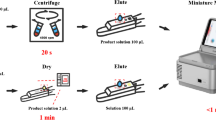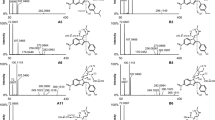Abstract
Anidulafungin is a semi-synthetic echinocandin with antifungal activity, usually administered as an intravenous infusion. In order to determine the pharmacokinetics (PK) of anidulafungin in pediatric patients, a sensitive high performance liquid chromatography-tandem mass spectrometry (HPLC-MS/MS) bioanalytical method (M1) was developed and validated for quantification of anidulafungin in plasma. During analysis of incurred samples (samples collected from patients enrolled in a clinical study) an isobaric chromatographic interference was observed. The source of interference was identified as an anidulafungin open-ring form (D1) and its impact on the quantification of anidulafungin was investigated. It was found that accurately quantifying anidulafungin in incurred samples required chromatographic separation of the open-ring form from anidulafungin. The method was redeveloped to achieve the appropriate baseline separation and to avoid experimental conditions that favored opening the anidulafungin ring. The extraction of anidulafungin from plasma by protein precipitation remained unchanged, but the changes in chromatography warranted validation of a new method, M2, 2 years after M1 was validated. Incurred samples from three studies that were previously analyzed by M1 and were within confirmed long-term frozen stability were then reanalyzed by M2. Although the incurred sample reproducibility tests on those samples passed for each of the two methods, comparison of concentrations from the same samples obtained by M1 and M2 revealed that an overestimation of anidulafungin following the M1 method exceeded acceptance criteria. The new HPLC-MS/MS method (M2) is applicable for quantification of anidulafungin within a nominal range 50–20,000 ng/mL and requires a 50 μL human plasma aliquot. A linear, 1/concentration squared weighted, least-squares regression algorithm was used to generate the calibration curve and its parameters were used to quantitate the incurred samples. The inter-assay accuracy in heparin human plasma validation ranged from −4.33 to 0.0386 % and precision was ≤7.32 %. The method M2 was validated for use in regulated bioanalysis and is presently used to quantitate anidulafungin in plasma samples from clinical studies.





Similar content being viewed by others
References
Raasch RH (2004) Anidulafungin: review of a new echinocandin antifungal agent. Expert Rev Anti Infect Ther 2(4):499–508
Dowell JA, Knebel W, Ludden T, Stogniew M, Krause D, Henkel T (2004) Population pharmacokinetic analysis of anidulafungin, an echinocandin antifungal. J Clin Pharmacol 44(6):590–598. doi:10.1177/009127000426564444/6/590
Dowell JA, Schranz J, Baruch A, Foster G (2005) Safety and pharmacokinetics of coadministered voriconazole and anidulafungin. J Clin Pharmacol 45(12):1373–1382. doi:10.1177/0091270005281234
Crandon JL, Banevicius MA, Fang AF, Crownover PH, Knauft RF, Pope JS, Russomanno JH, Shore E, Nicolau DP, Kuti JL (2009) Bronchopulmonary disposition of intravenous voriconazole and anidulafungin given in combination to healthy adults. Antimicrob Agents Chemother 53(12):5102–5107. doi:10.1128/AAC.01042-09
Sutherland CA, Nicolau DP, Kuti JL (2011) Development of an HPLC method for the determination of anidulafungin in human plasma and saline. J Chromatogr Sci 49(5):397–400
Farowski F, Cornely OA, Vehreschild JJ, Hartmann P, Bauer T, Steinbach A, Ruping MJ, Muller C (2010) Quantitation of azoles and echinocandins in compartments of peripheral blood by liquid chromatography–tandem mass spectrometry. Antimicrob Agents Chemother 54(5):1815–1819. doi:10.1128/AAC.01276-09
Decosterd LA, Rochat B, Pesse B, Mercier T, Tissot F, Widmer N, Bille J, Calandra T, Zanolari B, Marchetti O (2010) Multiplex ultra-performance liquid chromatography–tandem mass spectrometry method for simultaneous quantification in human plasma of fluconazole, itraconazole, hydroxyitraconazole, posaconazole, voriconazole, voriconazole-N-oxide, anidulafungin, and caspofungin. Antimicrob Agents Chemother 54(12):5303–5315. doi:10.1128/AAC.00404-10
Martens-Lobenhoffer J, Rupprecht V, Bode-Boger SM (2011) Determination of micafungin and anidulafungin in human plasma: UV- or mass spectrometric quantification? J Chromatogr B Analyt Technol Biomed Life Sci 879(22):2051–2056. doi:10.1016/j.jchromb.2011.05.033
Balkovec JM, Black RM, Hammond ML, Heck JV, Zambias RA, Abruzzo G, Bartizal K, Kropp H, Trainor C, Schwartz RE et al (1992) Synthesis, stability, and biological evaluation of water-soluble prodrugs of a new echinocandin lipopeptide. Discovery of a potential clinical agent for the treatment of systemic candidiasis and Pneumocystis carinii pneumonia (PCP). J Med Chem 35(1):194–198
Norris T, VanAlsten J, Hubbs S, Ewing M, Cai W, Jorgensen ML, Bordner J, Jensen GO (2008) Commercialization and late-stage development of a semisynthetic antifungal API: anidulafungin/d-fructose (Eraxis). Org Process Res Dev 12(3):447–455
Damle BD, Dowell JA, Walsky RL, Weber GL, Stogniew M, Inskeep PB (2009) In vitro and in vivo studies to characterize the clearance mechanism and potential cytochrome P450 interactions of anidulafungin. Antimicrob Agents Chemother 53(3):1149–1156. doi:10.1128/AAC.01279-08
US Department of Health and Human Services. Food and Drug Administration (FDA). Center for Drug Evaluation and Research (CDER). Guidance for Industry. Bioanalytical Method Validation. http://www.fda.gov/cder/guidance/4252fnl.htm. Accessed December 2008
Fast DM, Kelley M, Viswanathan CT, O’Shaughnessy J, King SP, Chaudhary A, Weiner R, DeStefano AJ, Tang D (2009) Workshop report and follow-up—AAPS workshop on current topics in GLP bioanalysis: assay reproducibility for incurred samples—implications of Crystal City recommendations. AAPS J 11(2):238–241. doi:10.1208/s12248-009-9100-9
Acknowledgment
The bioanalytical assay described in this manuscript was developed in collaboration with PPD and validated by PPD. This work was funded by Pfizer Inc. Michael Modesitt is a full-time employee of PPD. Tanja Alebic-Kolbah is a full-time employee of Pfizer. The authors would like to thank Ping Liu from Pfizer for her engagement and help during procedure development for PK sample collection and manuscript preparation. Gregory S Walker, Sharon Ripp, and Gregory L Weber from Pfizer are acknowledged for valuable contribution and discussion related to the anidulafungin open-ring form. Generous help in editing and peer-reviewing of the manuscript by Ileana Ionita from Pfizer is also acknowledged and highly appreciated. Thanks are due to Nada Kurt Stojkovic for reviewing the manuscript.
Author information
Authors and Affiliations
Corresponding author
Rights and permissions
About this article
Cite this article
Alebic-Kolbah, T., Modesitt, M.S. Anidulafungin—challenges in development and validation of an LC-MS/MS bioanalytical method validated for regulated clinical studies. Anal Bioanal Chem 404, 2043–2055 (2012). https://doi.org/10.1007/s00216-012-6272-4
Received:
Revised:
Accepted:
Published:
Issue Date:
DOI: https://doi.org/10.1007/s00216-012-6272-4




